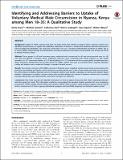| dc.contributor.author | Lanham, Michele | |
| dc.contributor.author | Hart, Catherine | |
| dc.contributor.author | Loolpapit, Mores | |
| dc.contributor.author | Oguma, Isaac | |
| dc.contributor.author | Obiero, Walter | |
| dc.contributor.author | Evens, Emily | |
| dc.date.accessioned | 2022-08-24T20:22:37Z | |
| dc.date.available | 2022-08-24T20:22:37Z | |
| dc.date.issued | 2014-06-05 | |
| dc.identifier.citation | Evens E, Lanham M, Hart C, Loolpapit M, Oguma I, et al. (2014) Identifying and Addressing Barriers to Uptake of Voluntary Medical Male Circumcision inNyanza, Kenya among Men 18–35: A Qualitative Study. PLoS ONE 9(6): e98221. doi:10.1371/journal.pone.0098221 | en_US |
| dc.identifier.other | PMID: 24901226 | |
| dc.identifier.other | PMCID: PMC4047024 | |
| dc.identifier.other | DOI: 10.1371/journal.pone.0098221 | |
| dc.identifier.uri | https://repository.amref.ac.ke/handle/123456789/784 | |
| dc.description | Copyright: ß2014 Evens et al. This is an open-access article distributed under the terms of the Creative Commons Attribution License, which permits unrestricted use, distribution, and reproduction in any medium, provided the original author and source are credited | en_US |
| dc.description.abstract | Background: Uptake of VMMC among adult men has been lower than desired in Nyanza, Kenya. Previous research has identified several barriers to uptake but qualitative exploration of barriers is limited and evidence-informed interventions have not been fully developed. This study was conducted in 2012 to 1) increase understanding of barriers to VMMC and 2) to inform VMMC rollout through the identification of evidence-informed interventions among adult men at high risk of HIV in Nyanza Province, Kenya.
Methods: Focus groups (n = 8) and interviews were conducted with circumcised (n = 8) and uncircumcised men (n = 14) from the two districts in Nyanza, Kenya. Additional interviews were conducted with female partners (n = 20), health providers (n = 12), community leaders (n = 12) and employers (n = 12). Interview and focus group guides included questions about individual, interpersonal and societal barriers to VMMC uptake and ways to overcome them. Inductive thematic coding and analysis were conducted through a standard iterative process.
Results: Two primary concerns with VMMC emerged 1) financial issues including missing work, losing income during the procedure and healing and family survival during the recovery period and 2) fear of pain during and after the procedure. Key interventions to address financial concerns included: a food or cash transfer, education on saving and employer-based benefits. Interventions to address concerns about pain included refining the content of demand creation and counseling messages about pain and improving the ways these messages are delivered.
Conclusions: Men need accurate and detailed information on what to expect during and after VMMC regarding both pain and time away from work. This information should be incorporated into demand creation activities for men considering circumcision. Media content should frankly and correctly address these concerns. Study findings support scale up and/or further improvement of these ongoing educational programs and specifically targeting the demand creation period. | en_US |
| dc.description.sponsorship | Bill & Melinda Gates Foundation under the Male Circumcision Consortium. | en_US |
| dc.language.iso | en | en_US |
| dc.publisher | Plos One | en_US |
| dc.subject | Nyanza | en_US |
| dc.subject | VMMC | en_US |
| dc.subject | HIV | en_US |
| dc.subject | Cirumcision | en_US |
| dc.title | Identifying and Addressing Barriers to Uptake of Voluntary Medical Male Circumcision in Nyanza, Kenya among Men 18-35: A Qualitative Study | en_US |
| dc.type | Article, Journal | en_US |

